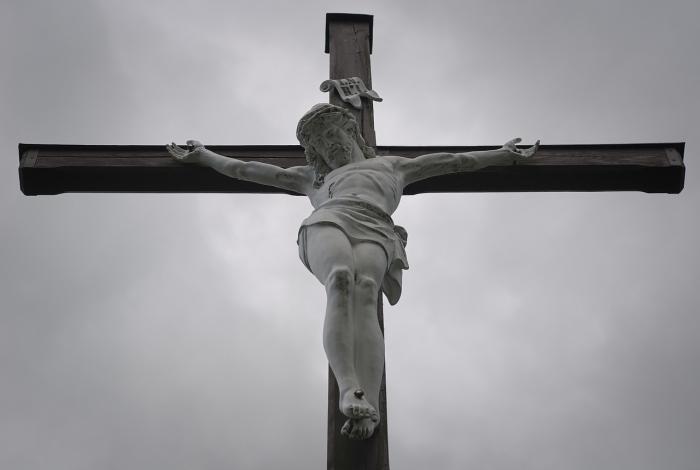
*Note, this is part II of my series on atonement. Part I can be found here. Please take a few minutes to read that first. Also, some of the content will be included in my forthcoming book entitled Heretic! An LGBTQ-Affirming, Divine-Violence Denying Christian Universalist’s Replies to Some of Evangelical Christianity’s Most Pressing Concerns.
If atonement theology is not best understood in penal substitutionary ways—as I contend it’s not—then what are some healthier, more orthodox ways of understanding the cross? Well, that’s what we’re going to get into.
Moral Influence
From the beginning, Christians have talked about the life and death of Christ as a model for our own lives. Clement of Alexandria (150–215 CE) was one of these:
For [Christ] came down, for this he assumed human nature, for this he willingly endured the sufferings of humanity, that he being reduced to the measure of our weakness, he might raise us to the measure of his power. And just before he poured out his offering, when he gave himself as ransom, he left us a new testament: “I give you my love.” What is the nature and extent of this love? For each of us he laid down his life, the life which was worth the whole universe, and he requires in return that we should do the same for each other.[1]
Later, however, Christ’s moral influence would be broadened into a way of talking about atonement more specifically. (Peter Abelard, a twelfth-century French theologian, is the one who gets credit for the development of the theory.) And, while it has its strengths, both biblically and ethically, it suffers only in that it simply doesn’t say enough about what happened in the life and death of Jesus. In other words, while the theory isn’t necessarily wrong—that is, Jesus Christ is the model of what it means to be “at-one” with the Father (John 5:19–20; 6:38; 8:28; 10:29; 12:49)—it leaves us wanting a more robust explanation as to how Jesus, and most specifically, the cross, saves us.
Christus Victor
That is where Christus Victor—the dominant theory of the Eastern Orthodox Church—can help lend a hand. In A Journey with Two Mystics, my best friend, Michael Machuga, sums up the theory with this beautiful catena of Scripture:
Satan has enslaved humanity with the fear of death (Heb 2:14–15). All manners of evil arise from this bondage. But Christ comes to set humanity free from Satan’s power, that is, “to destroy the devil’s work” (1 Pet 5:8). He does so by enduring the cross and by then being raised to life by God (Acts 2:23–25). In doing so, Christ “disarmed the rulers and authorities, exposing them to public disgrace by leading them in a triumphal parade” (Col 2:15). Christ is made Lord (Rom 14:11; Phil 2:11), given the Name above all names (Phil 2:9), and will reign until death, the last enemy, is destroyed (1 Cor 15:24–26). Death will then be cast into the lake of fire (Rev 20:10, 14) so that “God may be all in all” (1 Cor 15:28).[2]
Needless to say, an atonement theology such as this takes us much further than “moral influence.” Here, Christ is indeed our model for “moral living,” but he’s much more than that. Christus Victor proclaims that because of him, everything that stands in our way from being “at-one” with God has been defeated, including sin and death. And, excitingly, we can apply it in such a way that doesn’t necessitate a “traditionally sacrificial” interpretation of the cross, while at the same time taking sin seriously (a charge PSA folks tend to make against their non-PSA interlocutors).
In the following section, we are going to unpack what this may mean for us. Our goal, most specifically, will be to answer the question: How, exactly, does Christ’s death save us from “sin” and “death?”
The Victory of Christ
Death is Put to Death
Clearly, death is a problem. Allow me to rephrase. According to the writer of Hebrews, it is the problem: “So that through death he might destroy the one who has the power of death, that is, the devil, and free those who all their lives were held in slavery by the fear of death” (Heb 2:14–15, emphasis mine). The writer of 1 John also emphasizes that “The Son of God was revealed for this purpose, to destroy the works of the devil” (1 John 3:8). Put these together, and we can easily say that humanity’s greatest problem is that the devil and his works have enslaved humanity through the fear of death.
Incidentally, this fear of death is what cultural anthropologist Ernest Becker posited is the primary source of human-initiated suffering. That is to say, the neurosis death brings is the underlying cause of most of our violence (i.e., sin). What happens is that because we can think abstractly about our own death, we build these so-called “hero systems”—cultures, religions, political ideologies, and so on—that must be defended against all alternative systems. Psychologist Richard Beck explains how this mechanism works, and why it’s such a problem:
In short, alternative hero systems—other values, worldviews, and ways of life—threaten to undo everything that has made our lives feel significant, meaningful, and secure in the face of death. The ideological Other—usually some out-group member who has different values and beliefs from our own—presents us with an implicit critique of our personal hero system. This threatens us to the core, attacks the very source of our self-esteem. This means that the ideological Other—the out-group member who is simply different from us—doesn’t really have to do anything particularly threatening. His or her mere existence is enough to menace us. Outgroup members represent, on the edges of our awareness, a dissenting voice that suggest that the way we’ve constructed our identities and the criteria we’ve used to manage our self-esteem are not eternal and transcendent but are instead arbitrary human fictions.
So, what do we do in the face of that threat? Simply stated, we demonize these people. Rather than endure existential discomfort, it’s easier to double down on our worldview and to see those different from us as malevolent agents. We aggress against these “others.” In mild forms, we view them as confused or mistaken. More severely, they grow to become enemies we have to forcibly eliminate.[3]
All we have to do to see this play out in real-time is open our eyes. Look around and you will constantly see shots fired at one another. Not only do the Christians fight the Muslims (and vice-versa), but the Catholics fight the Protestants, and Protestants demonize the Anabaptists; Sunnis attack the Shias, and both go after the Sufis. More “secularly-speaking,” Capitalists demonize Socialists, while Socialists blame Capitalists for the world’s problems; but “New Atheists” know better and point to religion and its adherents as the true cause. And on and on it goes.
Regardless of who’s to blame, the answer to this dilemma, according to the earliest Christians, is in the person of Christ Jesus, who conquered death and the fear it brings. What Christ’s Victory emphasizes is that because of his death and subsequent resurrection, Christ triumphed over, among other things, not only the fear of death, but death itself. He died and went to Hades, conquered it, and now holds the keys (Rev 1:18). Whereas the devil once had the power to wield death as a way to keep humanity in bondage, Christ now has that power. But, with that power, he does the opposite of the devil; he comes to us, in all our confusion and misery, to show us that new life awaits us. He shatters our fear of death by showing us his hands and his side, and by forgiving us “while we were yet sinners” (Rom 5:8; John 20:19–20).
This is how we are saved from the bondage that our fear of death holds us under. By affirming the Resurrection—and as such, our own future resurrection—we open up new possibilities for our love to flow forth in the present. In other words, because we have nothing to hold onto any longer—now that the sting of death has been taken away—we are free to give ourselves in love for the other (the Greek term for this is kenosis). As the writer of 1 John tells us: “We know that we have passed from death to life because we love one another” (1 John 3:14). To put it in the simplest way I can, the dynamic duo of fear and death are undone by an even more dynamic duo: Love and Resurrection.[4]
The Subversion of Sacrifice
A second major problem Christ’s death saves us from is this business of sacrificing to the gods. For as long as humans have been around, we have been engaging in this practice. The greatest of the sacrifices have always been the purest: firstborn sons, virgin daughters, unblemished lambs, and so on. And while the penal substitutionary theory of the atonement keeps in line with this sacrificial thinking—the virgin Son is sacrificed to appease the wrath of the Father—the true message of the New Testament actually seems to be quite the opposite. In other words, the sacrifice of Jesus is not to be thought of as something that changes God and his mind, it is something that God does through Jesus that changes us and our ways of thinking. Thus, it saves us.
So, how exactly does God do this?
In two ways.
First, notice how the New Testament message flips the common way of sacrificial thinking on its head: God puts forth the Lamb, we receive him, yet God raises him up again. To put it this way, God offers the sacrifice to humans who cannot help but do what they do best. Yet God also gets the last word—the word of life. The writer of Acts repeatedly makes this point:
- Acts 2:23–24: “This man . . . you crucified . . . but God raised him up.”
- Acts 3:15: “You killed the Author of life, whom God raised from the dead.”
- Acts 4:10: “Jesus Christ of Nazareth, whom you crucified, whom God raised from the dead.”
In doing this, we are shown two things at the same time: what God is truly like and, consequently, what we are like. What I mean is that when the Father puts forth the Son (and, also, when he raises him up), it is to show how the whole sacrificial system is not something he desires, for he never desires death (Ezek 33:11), but rather, we do. I love how the writer of Hebrews drives home this very point:
Indeed, under the law almost everything is purified with blood, and without the shedding of blood there is no forgiveness of sins . . . [however] when, Christ came into the world, he said, “Sacrifices and offerings you have not desired, but a body you have prepared for me; in burnt offerings and sin offerings you have taken no pleasure. Then I said, ‘See, God, I have come to do your will, O God’ (in the scroll of the book it is written of me).” When he said above, “You have neither desired nor taken pleasure in sacrifices and offerings and burnt offerings and sin offerings” (these are offered according to the law), then he added, “See, I have come to do your will.” (Heb 9:22; 10:5–8, emphasis mine)
Notice the contrast: sacrifice and doing God’s will. On the one hand, the desire for sacrifice, while historically something we can’t help but project onto the entire pantheon of gods, is shown to be purely a human desire: “These are offered according to the law.” On the other hand, the one who perfectly does God’s will is the one who allows this law-based system to fall onto him while forgiving it all. Hence, Jesus shows us how the Father, rather than being just another god who demands sacrifice, is actually the one true God who becomes the sacrifice on our behalf. That is what we mean by “Christ died for us.” (Rom 4:25; 8:32) He dies for our benefit. Why? To expose the system for what it is—a system predicated on more and more blood and death (Luke 11:49–51)—while yet showing pure grace in the face of it.
The second point I want to make is that God takes humanity’s practice of ritualistic sacrifice and gives us a new ritual: the Eucharist. As Robert Hamerton-Kelly points out The Gospel and the Sacred, pretty much everything Jesus does during the Last Supper is subversive in nature:
The institution of the Eucharist is an inversion of the temple sacrifices. The usual direction of the sacrificial offering is reversed; instead of the worshiper giving to the god, the god is giving to the worshiper. Jesus “gives” (didomi) his body and blood, symbolized by bread and wine, to them instead of their giving their bodies and blood, symbolized by money, to the temple. Just as money symbolizes life given to the temple, so bread and wine symbolize the divine life given to the worshiper. Bruce Chilton suggests plausibly that the words of institution, “This is my body . . . this is my blood” (Mark 14:22–24) intend to present the breaking of the bread and the pouring of the wine as substitutes for the killing of victims in the temple. The room substitutes for the temple, the table for the altar, and the sharing of food for the killing of the victim. Normally, the worshiper brings the offering into sacred space; here, the upper room is the nonsacred counterpart of the holy of holies, and so the offering is made outside of sacred space. Thus, the sacrificial system is subverted by the reversal of the direction of its ritual logic.[5]
The beautiful thing about this whole event is that Jesus doesn’t simply tell his disciples what not to do, he gives us something to do. We are ritualistic creatures, after all, and as such, need rituals in order to get along in life. But these rituals demand blood. They demand victims. Not the Eucharist, however. This new ritual that leads to new community centers on a table, not an altar. It centers on bread and wine, not bodies and blood. It centers, even, on sharing this meal with one’s enemies. Remember, even Judas—the man Jesus knew would betray him—was present and had his feet washed by the Lord (John 13:1–5). Such is the inclusivity of the Eucharistic meal.
In Closing
At the end of the day, what matters most when it comes to atonement is whether we hold to a healing doctrine or not. Does our atonement theory bring peace or not? What I have discovered is that, while the nonviolent atonement theology I now affirm has done just that, my former views, ripe with penal language, never did. In fact, penal substitutionary atonement theory did just the opposite; it caused me great grief and confusion. For a time, it even played its part in driving me to atheism (and I know I’m not the only one).
That said, could PSA still be the most correct understanding of the Cross? Sure. One can find substitutionary language all throughout the Scriptures. One can read about God’s wrath and judicial nature as well. This cannot be disputed. But, what can be disputed is whether the sacrifice of Jesus is something that changes God’s mind about us, or whether it is to change our minds about God. To ask it this way: Does the cross save us from God or from something else (e.g. the Principalities and Powers, the practice of sacrifice, the fear of death, the devil, sin, and so on)? Throughout this series, I hope I did my job in showing that those who affirm the latter should be afforded a seat at the table with the majority of Western Christians who conclude the former; that we can offer some critique and pushback against their idea that, on the cross, the wrath of God was being poured out on a broken and bloody Jesus. A greater hope is that I did a bit more than that; namely that I put forth an understanding of the cross that actually subverts the “traditional” violent one that has troubled so many Christians and non-Christians alike.
[1] Clement, The Exhortation to the Greeks, 346.
[2] Distefano and Machuga, Journey, 43–44.
[3] Beck, Slavery of Death, 41–42.
[4] Ibid., xii.
[5] Hamerton-Kelly, The Gospel, 44.













